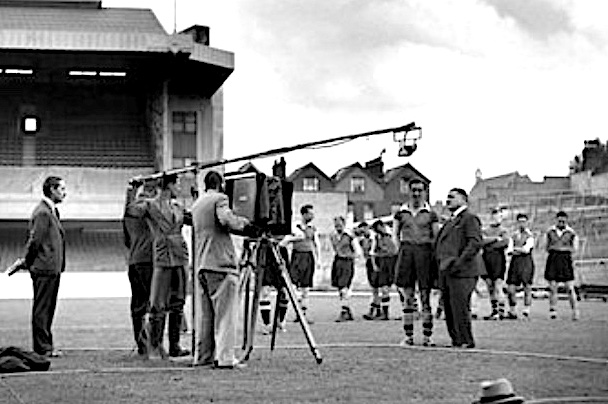OTD in early British television: 15 September 1937

John Wyver writes: For just over half an hour from 5.29pm on Wednesday 15 September 1937, a test outside broadcast from the Arsenal Football Club at Highbury showed part of a match between Arsenal Reserves and Millwall Reserves. Unbilled in Radio Times, this was essentially a trial for light levels, and yet it is nonetheless the earliest transmission of a professional football match.
The broadcast was the prelude to two days featuring broadcasts from Highbury. On Thursday, there was a 15-minute presentation from the pitch with commentator John Snagge, footballer Clifford Bastin and legendary Gunners manager George Allison (above). Friday featured shots of training, with team members including George Maleand Ted Drake introduced by Allison.
An anonymous contributor to The Listener provided a detailed description:
Although both broadcasts from the Arsenal last week, on Thursday afternoon and on Friday afternoon [the writer had missed the test broadcast], had considerable entertainment value of their own. their main interest lay in the knowledge that they were a foretaste of what , viewers may hope for in the future in the way of broadcasts of football matches.
For last Thursday’s and Friday’s programmes were another experiment in Outside Broadcasts of the type which began with the Coronation and was continued so successfully at Wimbledon.
Viewers were taken to the Arsenal Stadium at Highbury (courtesy of the Directors of the Arsenal Football Club), and shown a demonstration of training and practice by members of the Arsenal team. First. introduced by John Snagge, viewers met George Allison, the Manager of the team. and Mr. Allison in his turn introduced us to John Campbell, the Clerk of Works, and to Tom Whittaker, the trainer…
Tom Whittaker told us something of the methods used to train professional football players. Training begins as early as the Tuesday after August Bank Holiday every year, and consists in the beginning mainly of long periods of walking exercise. in the streets.
Later, in addition of course to playing football. P.T. takes place on the ground, and on Thursday we were able to watch this part of the Arsenal team’s work in progress. Lined up in rows the players performed such exercises as swinging their arms in slowly widening circles, bending to touch their toes, ‘ bicycling’ on their backs with their legs in the air, and finally taking a turn at the medicine ball.
This stage of the proceedings was enlivened by John Snagge’s deciding to take part in the circle of men and finding the medicine ball rather heavier than he had expected. Then we watched players practising exercises of more direct bearing on the game itself.
We were shown the difference between trapping a ball well and badly and were given an impressive exhibition of heading, the ball being passed from head to head with the appearance of the greatest ease, in spite of the fact that it was a smaller ball than is used in match play.
So much for last Thursday’s demonstration of training. What, after watching it, may the viewer expect of television in the near future in enabling him to watch his favourite team play in the big matches of the season?
On the whole, the promise of Thursday’s demonstration is high. It seems clear that football, like lawn tennis, is to become an imminently televisable game. The figures and actions of the players stood out clearly on the screen and the ball, being bigger than a tennis ball, can be seen more clearly when it is within reasonable distance of the camera.
It seems likely, however, that the successful television of Association and Rugby football matches will call for a far greater number of cameras, disposed at key positions about the ground, than are necessary for the smaller area at Wimbledon. This is due partly to the size of the ground, partly to the difficult background for photography made by the covered stands. In the distance they appear as a black screen against which it must be difficult to make the players stand out sharply.
It should be remembered also that football, being a winter game, cannot expect such satisfactory conditions of light as were obtainable at Wimbledon during the summer. However, on the whole the experiment at the Arsenal was full of promise and leads viewers to look forward with interest to the next Outside Broadcast.
[OTD post no. 272; part of a long-running series leading up to the publication on 8 January 2026 of my book Magic Rays of Light: The Early Years of Television in Britain, which can now be pre-ordered from Bloomsbury here.]
Leave a Reply